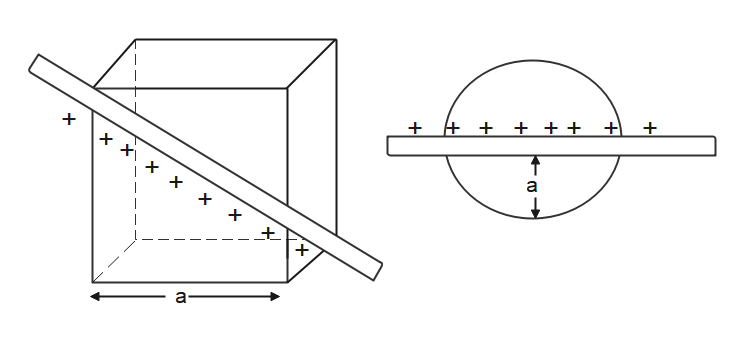
A linear charge having linear charge density

A)
B)
C)
D)

Answer
429.6k+ views
Hint: Coulomb's law deals with charges if the polarities of charges are the same then a repulsive force is created if the charges have different polarities then an attractive force is created. Coulomb’s law is an inverse square law; this law is analogous to Isaac Newton's inverse –square law of universal gravitation.
Formula Used:
Where, I is the amount of current flowing through the circuit,
Complete step-by-step solution:
Coulomb’s law states that the magnitude of electrostatic force between two point charges is directly proportional to the product of the magnitudes of charges and inversely proportional to the square of the distance between them
Where coulomb’s constant
Charge density
Properties of magnetic lines of force are:
Magnetic line density reduces as the distance between the poles increases
Magnetic field lines start from the North Pole and end at the South Pole.
Magnetic lines will not intersect with one another.
Two magnetic lines of force cannot intersect each other because if two magnetic field lines intersect there will be two directions of magnetic field at that point which is impossible.
Flux coming out of the cube is:
Flux coming out of the sphere is:
Dividing equation (1) by (2) then we get
So the correct option is C.
Note:Student’s the gravitational forces are always attractive while the electrostatic forces are either attractive or repulsive. The magnitude of electric field is obtained by coulomb’s law and in case of a unit stationary point charge coulomb’s law derivation formula is similar to gauss law derivation. The space around a charge is always under stress and experiences a force on another charge when placed there. The region or space in which stress exists is called the electric field (or dielectric or electrostatic) field.
Formula Used:
Where, I is the amount of current flowing through the circuit,
Complete step-by-step solution:
Coulomb’s law states that the magnitude of electrostatic force between two point charges is directly proportional to the product of the magnitudes of charges and inversely proportional to the square of the distance between them
Where coulomb’s constant
Charge density
Properties of magnetic lines of force are:
Magnetic line density reduces as the distance between the poles increases
Magnetic field lines start from the North Pole and end at the South Pole.
Magnetic lines will not intersect with one another.
Two magnetic lines of force cannot intersect each other because if two magnetic field lines intersect there will be two directions of magnetic field at that point which is impossible.
Flux coming out of the cube is:
Flux coming out of the sphere is:
Dividing equation (1) by (2) then we get
So the correct option is C.
Note:Student’s the gravitational forces are always attractive while the electrostatic forces are either attractive or repulsive. The magnitude of electric field is obtained by coulomb’s law and in case of a unit stationary point charge coulomb’s law derivation formula is similar to gauss law derivation. The space around a charge is always under stress and experiences a force on another charge when placed there. The region or space in which stress exists is called the electric field (or dielectric or electrostatic) field.
Recently Updated Pages
Master Class 12 Business Studies: Engaging Questions & Answers for Success

Master Class 12 English: Engaging Questions & Answers for Success

Master Class 12 Social Science: Engaging Questions & Answers for Success

Master Class 12 Chemistry: Engaging Questions & Answers for Success

Class 12 Question and Answer - Your Ultimate Solutions Guide

Master Class 11 Economics: Engaging Questions & Answers for Success

Trending doubts
Draw a labelled sketch of the human eye class 12 physics CBSE

a Tabulate the differences in the characteristics of class 12 chemistry CBSE

Which one of the following is a true fish A Jellyfish class 12 biology CBSE

Why is the cell called the structural and functional class 12 biology CBSE

Differentiate between homogeneous and heterogeneous class 12 chemistry CBSE

Write the difference between solid liquid and gas class 12 chemistry CBSE




